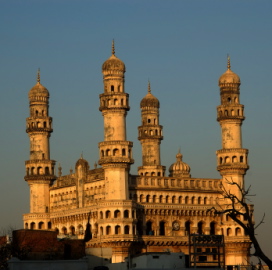
Hyderabad, May 18 (IANS) — A nationwide alert was sounded in the aftermath of the blasts. Majlis-e-Ittehadul Muslimeen (MIM) legislator Akbaruddin Owaisi said: “Seven people have died in the blast (at the Mecca Masjid) and six in police firing.” More than 40 people were wounded in the blast in the 17th century Mecca Masjid in the old city area.
The crude bomb, hidden in a tiffin box under a stone bench in the Mecca Masjid, exploded at 1.30 p.m. – probably set off from a cell phone just as thousands of worshippers prepared to conclude their namaaz, or weekly Friday prayers. Police later found a cell phone that they suspect may have been used to trigger the blast.
The blast took place near the ‘wazu khana’ or water tank, where Muslims go through ablutions before offering prayers. Five people were killed on the spot while two died in hospital.
Panic-stricken worshippers gave their account of the incident. “I heard a loud thud as we were about to complete the prayers. The Imam (head priest) asked people not to panic as people thought a tyre had burst,” said Rafeeq Ahmed, who was offering prayers inside the main building of the mosque. “Seconds later, people were running in panic. I came out and saw human body parts strewn around and the injured were being shifted,” he told IANS.
The death toll in the Mecca Mosque blast would have been higher, but three more bombs were detected and defused in the mosque premises within an hour of the explosion, officials said.
But reaction was swift across Hyderabad city, and particularly in the Old City, as crowds vented their anger.
Friday’s attack was the third major bombing of a mosque in the last year. In September 2006, 31 people were killed in a bomb attack on a mosque in Malegaon in Maharashtra. In that attack, bombs mounted on bicycles exploded as devotees emerged from prayers.
Background information on Mecca Masjid
Located near the Charminar, the symbol of Hyderabad, in the walled quarter of the city, the impressive structure has witnessed protests on various occasions by Muslim youth after Friday prayers. It is visited by hundreds of domestic and foreign tourists.
On Fridays and two annual festivals, the mosque witnesses huge congregations. People from different parts of the city offer weekly prayers here as they have emotional attachment to the mosque, which was built with some bricks brought from Mecca, Islam’s holiest place in Saudi Arabia.
The area around the mosque has seen violent demonstrations in the past. During the last decade some Muslims tried to take out rallies after Friday prayers on several occasions leading to violence.
Clashes between police and demonstrators took place when rallies were attempted to protest the 1992 demolition of Babri mosque, the US attacks on Afghanistan and Iraq, US President George Bush’s visit to Hyderabad and the insulting caricatures of the Prophet Mohammed.
The police have installed surveillance cameras around the mosque and on every Friday elaborate security arrangements are in place. Frisking of devotees on some occasions has also evoked sharp protests from the community.
The construction of the historic mosque was started by Mohammed Quli Qutub Shah in 1614 and was completed by Mughal Emperor Aurangzeb in 1694. Since the bricks used in the construction were brought from the Saudi Arabian city of Makkah, Islam’s holiest site, it was given the name Mecca Masjid. The mosque also has tombs of the Nizams, the erstwhile rulers of Hyderabad, and their family members.
© 2007 IANS India Private Limited, New Delhi. Posted on Religioscope with permission. — Indo-Asian News Service (IANS) is India’s first multinational and multilingual wire service. Website: www.ians.in. Subscription enquiries: contact IANS (mention Religioscope).